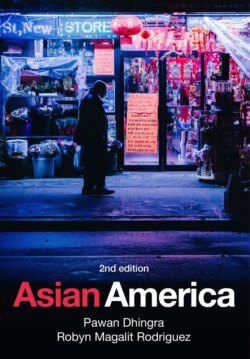Читать книгу Asian America - Pawan Dhingra - Страница 48
The “yellow peril”
ОглавлениеOnce we think outside of the black–white binary, we can better recognize the main stereotypes impacting Asian Americans – the “yellow peril” and the “model minority.” The “yellow peril” casts Asians and Asian Americans as economic, political, biological, and sexual threats to the West, wanting to take it over. When the “yellow peril” stereotype is active, Asian Americans are not only foreigners but low on the valorization scale. The stereotype is based in Orientalist framing of Asians (broadly defined) and extended to Asian Americans as the opposite of the ideal westerner (Said 1978). As the westerner is rational, kind, clean, and sexually decent, the Oriental is irrational, conniving, dirty, and sexually deviant. The West needs to depict the Orient in this light in order to construct itself in its desired image. Critics of this analysis argue that European and American imaginings of the Middle East and Asia were more heterogeneous and complicated than Said suggests (Macfie 2000). Still, Orientalism proved to be a compelling discourse incorporated into much of the West’s imaginings of Asia. The threat from Asia was military, economic, sexual, and cultural.
As an extension of Orientalism, in the last century and a half the American citizen has been defined over and against the Asian immigrant legally, economically, and culturally. These definitions have cast Asian immigrants, both as persons and as populations, to be integrated into the national political sphere and as the contradictory, confusing, unintelligible elements to be marginalized and returned to their alien origins. “Asia” has always been a complex site upon which the manifold anxieties of the United States nation-state have been figured: such anxieties have represented both Asian countries as exotic, barbaric, and alien, and Asian laborers immigrating to the United States from the nineteenth century onward as a “yellow peril” threatening to displace white European immigrants.
The “yellow peril” stereotype is not always at play but arises when the United States is at war and/or when there is a “crisis of capital,” meaning when capitalist interests are not clearly dominant either domestically or globally due to competition and rising costs (Ong, Bonacich, and Cheng 1994). With the majority of US wars in the past hundred years being with Asian and Arab countries, Asian Americans have borne the brunt of racism as the supposed “foreigner within.” Even if US-born, fluent in English, and so on, Asian Americans can be targeted as foreign threats. It does not need to be a literal war for Asian Americans to be targeted as a threat. The economic contests with Japan in the 1980s made Japanese Americans and those assumed to be Japanese the targets of resentment, including the murder of Vincent Chin as discussed below. The coronavirus also appears as a threat akin to war, with the number of dead compared to wartime deaths, America declaring war on the coronavirus, and President Trump calling himself a “wartime president.”4 Like all formal or informal wars that involve Asia, Asian Americans become unnecessary casualties to hate.
During uneasy security and economic times, an external agent, such as the “yellow peril,” unites “real Americans.” Asia and Asian Americans come to represent the morally suspicious threat to the virtuous and benevolent United States. Orientalist racializations of Asians as physically and intellectually different from whites predominated, especially in periods of intense anti-Asian labor movements, culminating in institutionalized discrimination, such as immigration exclusion acts and laws against the naturalization of Chinese in 1882, Indians in 1917, Japanese and Koreans in 1924, and Filipinxes in 1934. The stereotype also comes up when whites feel under threat from Asian Americans in other ways, such as if Asian culture feels too prevalent in their geographic areas (Cheng 2013).
